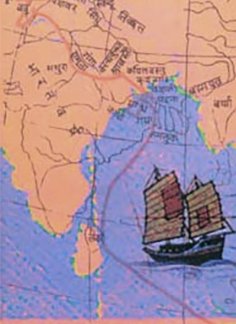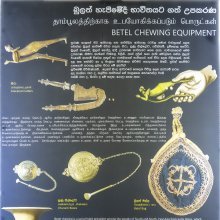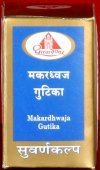Betel leaf: 2 definitions
Introduction:
Betel leaf means something in Hinduism, Sanskrit, the history of ancient India. If you want to know the exact meaning, history, etymology or English translation of this term then check out the descriptions on this page. Add your comment or reference to a book if you want to contribute to this summary article.
Images (photo gallery)
In Hinduism
Natyashastra (theatrics and dramaturgy)
Source: Shodhganga: Elements of Art and Architecture in the Trtiyakhanda of the Visnudharmottarapurana (natya)Betel leaves are associated with Kapittha-hasta: one of the twenty-two Single-hand Gestures (in Indian Dramas) (known as asaṃyuktahastas), according to the Viṣṇudharmottarapurāṇa, an ancient Sanskrit text which (being encyclopedic in nature) deals with a variety of cultural topics such as arts, architecture, music, grammar and astronomy.—In the Śabdakalpadruma, the word kapittha is explained as a kind of tree where kapi i.e., monkey comes due to the greed of fruit. The word kapittha again denotes the fruit called wood apple. [...] Apart from holding a garland and necklace, the Abhinayadarpaṇa also suggests the use of this posture to show the activities like picking flowers, offering betel leaves, preparing paste, applying perfumes etc.

Natyashastra (नाट्यशास्त्र, nāṭyaśāstra) refers to both the ancient Indian tradition (shastra) of performing arts, (natya—theatrics, drama, dance, music), as well as the name of a Sanskrit work dealing with these subjects. It also teaches the rules for composing Dramatic plays (nataka), construction and performance of Theater, and Poetic works (kavya).
India history and geography
Source: Google Books: Medieval Orissa: A Socio-economic StudyBetel leaf sellers in ancient India (Medieval Orissa) represented one of the occupational groups commonly found in Townships or Urban centers (nagari).—An example (of Township) is provided by the Nagari plates of Anangabhima III, dated A.D. 1230, which describe an assigned township which contained four large houses of the dimension of royal residences and thirty other houses. The occupational groups present in the settlement were [e.g., a seller of betel leaf (tāmbulika)]. The range of occupations is large, some of them being rural in character. The context in which the township (or Urban centres—nagari) is assigned suggest that nagaris in such cases were perhaps extended villages, formed out of a cluster of several contiguous villages and thus assuming physical and consequently, economic dimensions much larger than those of an ordinary village settlement.

The history of India traces the identification of countries, villages, towns and other regions of India, as well as mythology, zoology, royal dynasties, rulers, tribes, local festivities and traditions and regional languages. Ancient India enjoyed religious freedom and encourages the path of Dharma, a concept common to Buddhism, Hinduism, and Jainism.
See also (Relevant definitions)
Partial matches: Leaf.
Full-text (+303): Tambula, Panamala, Tamboli, Panadana, Panapuda, Paan, Parparina, Phodani, Mukhavasa, Badakhasa, Baydambula, Elecamci, Gilauri, Gatriga, Hottalu, Hannavaniga, Dholi, Elekavu, Adakele, Elegara.
Relevant text
Search found 64 books and stories containing Betel leaf; (plurals include: Betel leaves). You can also click to the full overview containing English textual excerpts. Below are direct links for the most relevant articles:
Rasa Jala Nidhi, vol 4: Iatrochemistry (by Bhudeb Mookerjee)
Part 13 - Chewing of betel leaves < [Chapter I - General health prescriptions]
Treatment for fever (128): Parna-khandeshvara rasa < [Chapter II - Fever (jvara)]
Treatment for fever (24): Sarvanga-sundara-chintamani rasa < [Chapter II - Fever (jvara)]
The Skanda Purana (by G. V. Tagare)
Chapter 210 - Importance of Tāmbūla < [Section 1 - Tīrtha-māhātmya]
Chapter 7 - Code of Conduct for Women etc. < [Section 2 - Dharmāraṇya-khaṇḍa]
Chapter 169 - The Abduction of Kāmamohinī < [Section 3 - Revā-khaṇḍa]
Kathasaritsagara (the Ocean of Story) (by Somadeva)
Part 3 - Southern India < [Appendix 8.2 - The Romance of Betel-Chewing]
Part 1 - Betel-Chewing in India prior to a.d. 1800 < [Appendix 8.2 - The Romance of Betel-Chewing]
Part 5 - The Malay Peninsula < [Appendix 8.2 - The Romance of Betel-Chewing]
Folk Tales of Gujarat (and Jhaverchand Meghani) (by Vandana P. Soni)
Chapter 13 - Vanadiya Ni Varta < [Part 3 - Kankavati]
Chapter 5 - Maluva < [Part 1 - Saurashtra ni Rashdhar]
Village Folk-tales of Ceylon (Sri Lanka), vol. 1-3 (by Henry Parker)
Story 28 - The Female Quail < [Part I - Stories told by the Cultivating Caste and Vaeddas]
Story 8 - The Prince And The Princess < [Part I - Stories told by the Cultivating Caste and Vaeddas]
Story 23 - Kurulu-gama Appu, The Sooth-sayer < [Part I - Stories told by the Cultivating Caste and Vaeddas]
Related products



